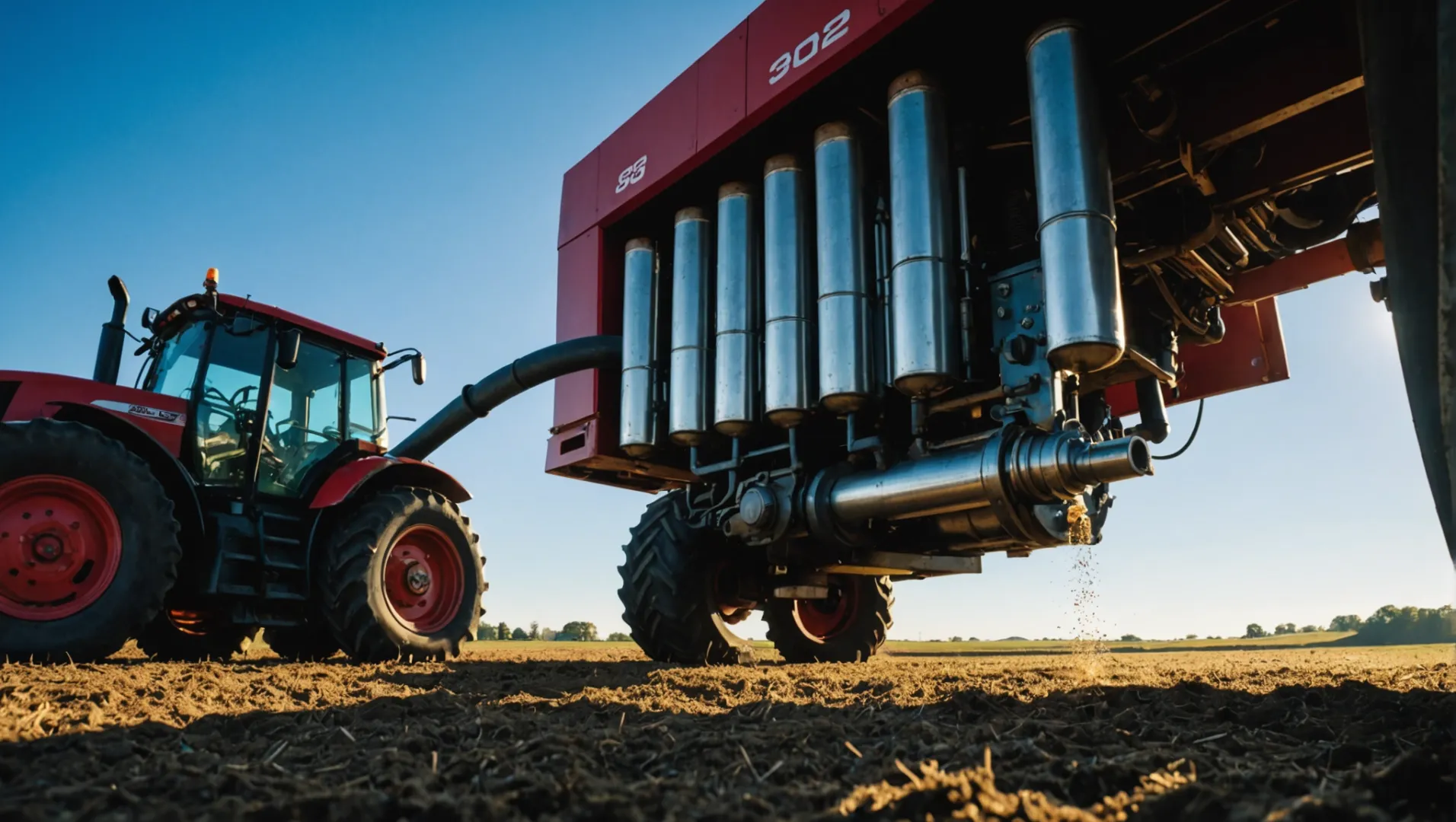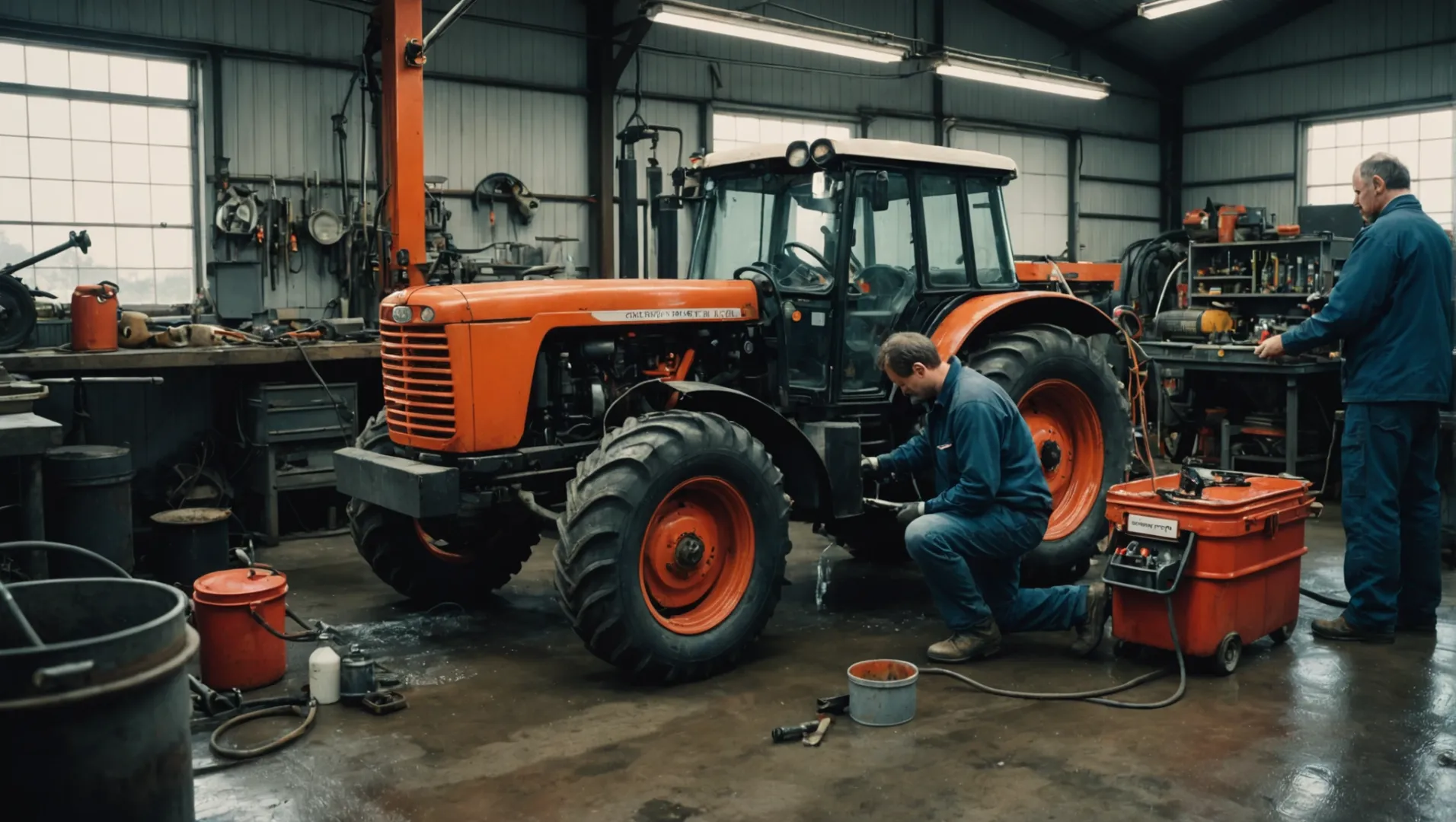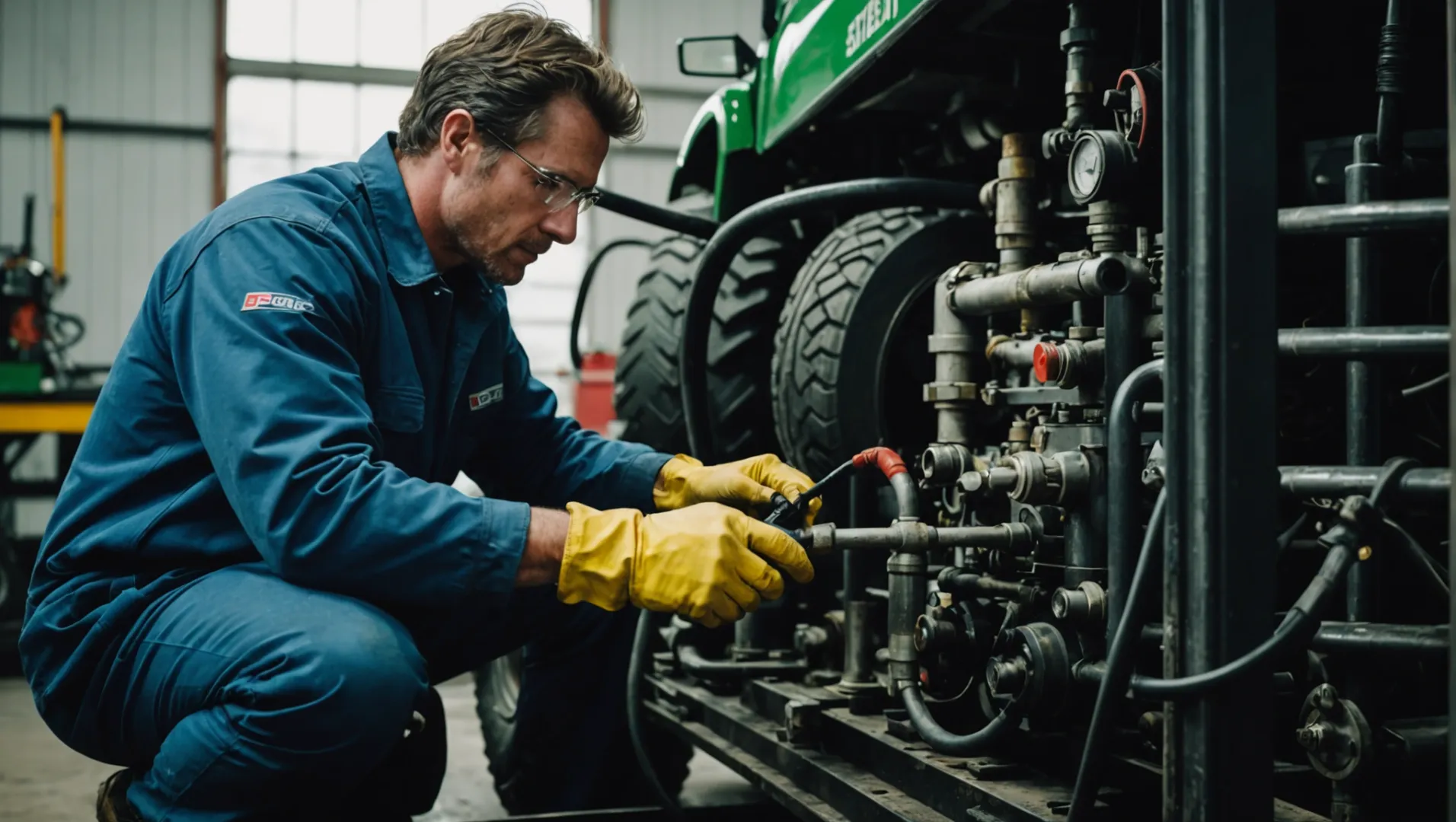As a tractor owner, I understand how crucial it is to keep my equipment running smoothly. One of the most vital parts of that maintenance is managing hydraulic fluid changes.
Hydraulic fluid in tractors should generally be changed every 1,000 hours of operation or once a year, depending on usage intensity and manufacturer's recommendations. Regular checks can prevent issues before they arise.
But there's more to it than just following a guideline. Let’s dive into the specifics that will help you make an informed decision about your tractor's hydraulic fluid changes.
Tractor hydraulic fluid should be changed every 1,000 hours.True
Changing hydraulic fluid every 1,000 hours or yearly prevents system issues.
What Are the Signs That Hydraulic Fluid Needs Changing?
Recognizing when hydraulic fluid needs changing is crucial for maintaining your tractor's efficiency and preventing costly repairs.
Signs that hydraulic fluid needs changing include discoloration, unusual odors, particles in the fluid, noisy pumps, and sluggish hydraulic response. Regular inspection helps identify these signs early.

Visual Indicators of Hydraulic Fluid Degradation
One of the primary signs that your hydraulic fluid might need changing is a change in its color. Fresh hydraulic fluid typically has a clear, amber hue. If you notice the fluid turning dark or cloudy, it could be a sign of contamination or oxidation. Additionally, checking for particles or sediment at the bottom of the hydraulic reservoir can also indicate contamination.
Odor is another sensory indicator. If the hydraulic fluid smells burnt or unusual, it may have degraded and requires replacement. This is often caused by overheating or chemical breakdowns within the fluid.
Performance-Based Signs
Pay attention to how your tractor's hydraulic system performs. If the system starts to behave unusually, such as producing noisy pumps or exhibiting sluggish hydraulic responses, these could be signs that the hydraulic fluid is no longer performing optimally. These performance issues can arise from contaminated or degraded fluid, which affects the system's efficiency.
A telltale sign of needing a fluid change is when the system experiences pressure drops or inconsistent operation. This can indicate that the fluid’s viscosity has altered beyond acceptable limits, impacting its ability to transfer energy effectively.
Importance of Regular Inspections
Regular inspections are vital to catch these signs early before they lead to more significant problems. Checking fluid levels and conditions should be part of routine maintenance. For those operating in heavy-use scenarios or under harsh conditions, frequent checks are recommended.
Using tools like dipsticks or sight glasses can assist in quickly assessing fluid condition without having to dismantle parts of the system.
Tables like the one below can help schedule regular checks:
| Condition | Check Frequency |
|---|---|
| Heavy Use | Before Each Use |
| Moderate Use | Weekly |
| Light Use | Bi-Weekly |
For more detailed guidance on specific inspection techniques1, refer to manufacturers' manuals or professional advice to ensure accuracy and safety in maintenance.
Monitoring for Unusual System Behavior
Be aware of any changes in your tractor's hydraulic performance. Noisy operations or unusual mechanical sounds may suggest an issue with the fluid or system components. It’s crucial to address these issues promptly to avoid extensive damage.
Understanding these signs and acting promptly can save time and resources in maintaining your tractor's hydraulic system effectively.
Dark hydraulic fluid indicates contamination.True
Dark or cloudy hydraulic fluid suggests contamination or oxidation.
Burnt smell in fluid means it's still usable.False
A burnt odor indicates degradation, requiring fluid replacement.
How Does Usage Intensity Affect Hydraulic Fluid Maintenance?
Usage intensity plays a pivotal role in determining the frequency of hydraulic fluid maintenance, directly impacting system performance.
Heavy usage or harsh conditions accelerate hydraulic fluid degradation, necessitating more frequent maintenance checks and changes. Regular monitoring ensures system longevity.

Understanding Usage Intensity and Its Impact
Usage intensity refers to how frequently and how strenuously a hydraulic system is utilized. This includes factors like operating hours, load weight, and environmental conditions. For instance, a tractor employed in construction, constantly lifting heavy materials, experiences greater strain compared to one used for lighter tasks such as mowing. Such intense usage accelerates fluid degradation.
Environmental Conditions: An Overlooked Factor
Operating in harsh environments can significantly alter hydraulic fluid maintenance needs. Dusty or dirty settings increase the likelihood of fluid contamination, while extreme temperatures can affect fluid viscosity, leading to reduced effectiveness. In these scenarios, hydraulic systems may require more frequent checks and changes to maintain optimal performance.
Monitoring and Adjusting Maintenance Intervals
To ensure the hydraulic system remains efficient, it's crucial to monitor the condition of the fluid regularly. Regular checks2 can help detect early signs of wear or contamination. For tractors under heavy use, checking fluid levels before each operation might be necessary. For less intensive use, weekly inspections may suffice. Adjusting maintenance intervals based on usage intensity and environmental factors is key to preventing system failures.
Case Study: Comparing Maintenance Strategies
Consider two tractors: one used on a farm for daily fieldwork and another for sporadic weekend gardening tasks. The farm tractor, facing constant heavy-duty tasks, may require bi-annual fluid changes, whereas the garden tractor might only need an annual check. This comparison illustrates how usage intensity directly influences maintenance schedules and overall system health.
For more insights on how to adjust your maintenance strategy based on usage conditions, explore manufacturer guidelines3 tailored to specific tractor models.
Heavy usage accelerates hydraulic fluid degradation.True
Intense use increases wear and tear, degrading fluid faster.
Environmental conditions have no impact on fluid maintenance.False
Harsh environments can increase contamination, affecting maintenance.
Why Is It Important to Use the Correct Hydraulic Fluid?
Choosing the right hydraulic fluid is crucial for maintaining your tractor's performance and extending its lifespan.
Using the correct hydraulic fluid ensures optimal performance, prevents system damage, and reduces maintenance costs. Incorrect fluid can lead to increased wear, reduced efficiency, and potential system failures.

Ensuring Optimal Performance
Using the correct hydraulic fluid is essential to maintain the efficiency and performance of your tractor’s hydraulic system. Each hydraulic system is designed with specific parameters, including viscosity, lubricity, and temperature tolerance. The right fluid ensures that these parameters are met, allowing the system to operate smoothly under various conditions.
Preventing System Damage
Incorrect hydraulic fluid can lead to various forms of damage, such as corrosion, seal degradation, and increased friction. These issues can cause components like pumps and valves to wear out prematurely. For example, using a fluid with inappropriate viscosity can result in inadequate lubrication, leading to increased wear and tear. This is particularly critical when operating in extreme temperatures where fluid properties can be compromised.
Reducing Maintenance Costs
While opting for cheaper or incorrect hydraulic fluid might seem cost-effective initially, it often leads to higher maintenance costs in the long run. Regular use of unsuitable fluid can result in frequent breakdowns and repairs. By sticking to the recommended hydraulic fluid, you ensure that your system remains in peak condition, thereby reducing unexpected maintenance expenses.
Compatibility with System Components
Hydraulic systems include various materials like seals, hoses, and pumps that must be compatible with the hydraulic fluid. Incompatible fluids can cause material swelling or shrinkage, leading to leaks or failures. Therefore, always refer to your tractor’s manual to identify the correct type of hydraulic fluid and avoid potential compatibility issues.
Case Studies on Fluid Misuse
- Case 1: A farmer using an incompatible hydraulic fluid noticed increased noise from the hydraulic pump and sluggish system response. After switching back to the recommended fluid, the system returned to normal operation.
- Case 2: An industrial tractor experienced frequent seal failures due to incorrect hydraulic oil. The issue was resolved by consulting the manufacturer’s guide for the right fluid specifications.
These examples underscore the importance of using correct hydraulic fluids4 tailored to your tractor’s design and operational requirements.
Using incorrect hydraulic fluid increases maintenance costs.True
Incorrect fluid leads to more breakdowns, raising repair expenses.
All hydraulic fluids are compatible with any tractor system.False
Different systems require specific fluids for compatibility.
Should You Flush the Hydraulic System During a Fluid Change?
Hydraulic fluid maintenance is crucial for optimal tractor performance, but should you always flush the system during a fluid change?
Flushing the hydraulic system during a fluid change is advisable if the system shows signs of contamination, unusual noise, or sluggish operation. This ensures all residues and contaminants are removed, promoting efficient operation.

Understanding the Need for Flushing
Flushing a hydraulic system involves removing all existing fluid and contaminants before adding new fluid. This process can prevent potential issues like reduced efficiency and mechanical failures. However, it's not always necessary and depends largely on the condition of the fluid and the system.
When to Consider Flushing
- Visible Contamination: If you notice particles or debris in the fluid, flushing can help eliminate these contaminants.
- Fluid Discoloration: Dark or milky fluid indicates oxidation or water contamination, signaling a need for flushing.
- Unusual System Behavior: Noisy pumps or sluggish hydraulic responses are red flags that might necessitate a complete system flush.
How to Properly Flush Your System
Following a systematic approach ensures all old fluid and contaminants are expelled:
- Drain the Old Fluid: Begin by draining the old hydraulic fluid completely. This involves removing drain plugs and ensuring that no old fluid remains in the system.
- Clean the Reservoir: Use a lint-free cloth to wipe out the reservoir, removing any sludge or residues.
- Flush with Clean Fluid: Introduce new hydraulic fluid to "flush" out any remaining contaminants, circulating it through the system before draining it again.
Benefits of Flushing
- Enhanced Performance: Clean systems operate more efficiently and are less prone to breakdowns.
- Extended Component Life: Regular flushing can prolong the life of critical components by preventing wear and tear caused by contaminants.
For more guidance, check out resources on hydraulic system maintenance5. Flushing might seem like an extra step, but it can be invaluable in maintaining your tractor's efficiency over time.
Flushing is always necessary during a fluid change.False
Flushing depends on system condition, not always needed.
Contaminated fluid signals need for system flushing.True
Contamination indicates flushing to remove debris and residues.
Conclusion
Regular maintenance of hydraulic fluid ensures smooth operation and extends your tractor’s life. Reflect on your current practices and adjust if necessary for better efficiency.
-
Learn precise techniques for inspecting hydraulic fluid condition.: All hydraulic hoses should be inspected for wear, bubbles, leaks and twisting. Any corrosion in pipes needs to be addressed immediately. ↩
-
Learn practical steps for effective hydraulic fluid inspections.: The correct method to ensure you have the right amount of hydraulic fluid in your system. ↩
-
Find expert-recommended intervals for specific tractor models.: Hydraulic systems need regular check-ups. Equipment manufacturer guidelines will recommend an ideal frequency for checking and replacing specific components. ↩
-
Explore real-world examples and detailed explanations of why correct fluids matter.: The hydraulic system alone is critical for optimal tractor performance, so keeping it well-oiled with the appropriate fluid levels is vital to ... ↩
-
Learn about key benefits and techniques for effective hydraulic system maintenance.: If a hydraulic system becomes contaminated with water or anything else, it has to be completely disassembled and ALL components drained and flushed. ↩



